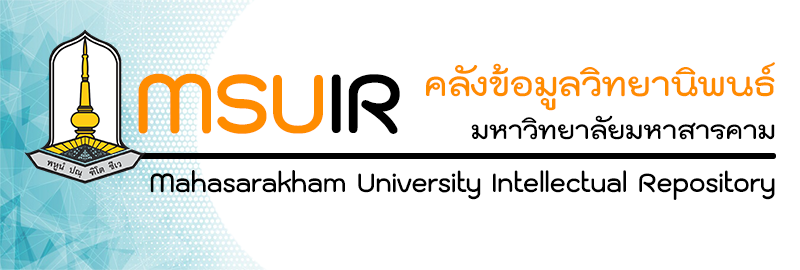Please use this identifier to cite or link to this item:
http://202.28.34.124/dspace/handle123456789/2676| Title: | Optimal Reservoir Operation using Invasive Weed Optimization Algorithm. การประยุกต์ใช้วิธีอัลกอริทึมการหาค่าเหมาะสมแบบวัชพืชรุกรานเพื่อปรับปรุงโค้งควบคุมของอ่างเก็บน้ำ |
| Authors: | Pinmanee Promaruk ปิ่นมณี พรหมอารักษ์ Anongrit Kangrang อนงค์ฤทธิ์ แข็งแรง Mahasarakham University Anongrit Kangrang อนงค์ฤทธิ์ แข็งแรง anongrit.k@msu.ac.th anongrit.k@msu.ac.th |
| Keywords: | อัลกอริธึมการเพิ่มประสิทธิภาพวัชพืชแบบรุกราน อัลกอริทึมทฤษฎีเชิงพันธุกรรม การบริหารจัดการน้ำ โค้งควบคุมอ่างเก็บน้ำ Invasive Weed Optimization (IWO) algorithm Genetic Algorithm (GA) water resources management reservoir rule curves |
| Issue Date: | 25 |
| Publisher: | Mahasarakham University |
| Abstract: | Effective management of water resources in reservoirs is critical for optimizing their utilization to achieve maximum benefits. This study introduces a novel approach that integrates the Invasive Weed Optimization (IWO) algorithm with a reservoir simulation model to enhance the efficiency of reservoir rule curves. The Phuttha Uthayan Reservoir, located in Mueang District, Amnat Charoen Province, was selected as a case study, with a focus on its contributions to agriculture, irrigation, and local water consumption. The effectiveness of the newly developed rule curves was evaluated using a synthetic dataset of inflows spanning 500 years. The analysis examined the frequency, volume, and duration of water releases under scenarios of both shortages and excess water, comparing the results with the current operational rule curves. The findings indicate that the IWO-generated rule curves, developed based on historical inflow data and across four objective functions, exhibited no water shortages across all scenarios. While the existing rule curves recorded an annual excess of 1.09 million cubic meters and a maximum excess of 7.28 million cubic meters, the IWO-generated curves reduced the annual excess to 1.085 million cubic meters while maintaining the same maximum excess. The Genetic Algorithm (GA) technique yielded slightly lower annual and maximum excesses of 1.07 million cubic meters and 7.22 million cubic meters, respectively. The results demonstrate that the IWO algorithm performs comparably to the GA technique under identical objective functions and outperforms the existing rule curves. The IWO-generated curves are particularly effective under normal water conditions, more efficiently mitigating excess water issues, and enhancing reservoir performance. The alignment of the lower bounds with existing curves increases the likelihood of meeting targeted water demands, while the higher upper bounds allow for greater storage capacity, reducing occurrences of excess water.This research contributes significantly to the development of sustainable water resource management strategies and provides practical insights for improving reservoir operations in the region. การบริหารจัดการน้ำในอ่างเก็บน้ำอย่างมีประสิทธิผลเป็นปัจจัยสำคัญในการเพิ่มประสิทธิภาพการใช้งานทรัพยากรน้ำให้เกิดประโยชน์สูงสุด งานวิจัยนี้นำเสนอวิธีการใหม่ที่ผสมผสานอัลกอริธึมการเพิ่มประสิทธิภาพวัชพืชแบบรุกราน (Invasive Weed Optimization - IWO) เข้ากับแบบจำลองการจำลองอ่างเก็บน้ำ เพื่อปรับปรุงเส้นโค้งการควบคุมของอ่างเก็บน้ำ การศึกษานี้ได้เลือกอ่างเก็บน้ำพุทธอุทยานในเขตอำเภอเมือง จังหวัดอำนาจเจริญ เป็นกรณีศึกษาโดยให้ความสำคัญกับประโยชน์ของอ่างเก็บน้ำดังกล่าวในด้านการเกษตร การชลประทาน และการบริโภคในท้องถิ่นของประชาชนในเขตอำเภอเมือง งานวิจัยนี้ได้ประเมินประสิทธิผลของเส้นโค้งควบคุมใหม่ในการดำเนินการจัดการน้ำของอ่างเก็บน้ำ โดยใช้ชุดข้อมูลปริมาณน้ำที่ไหลเข้าอ่างเก็บน้ำแบบสังเคราะห์ที่ครอบคลุมระยะเวลา 500 ปี เพื่อวิเคราะห์ความถี่ ปริมาตร และระยะเวลาของการปล่อยน้ำในสภาวะที่เกิดการขาดแคลนและการไหลล้น พร้อมเปรียบเทียบกับเส้นโค้งควบคุมที่ใช้งานอยู่ในปัจจุบัน ผลการวิจัยพบว่าผลการสร้างโค้งควบคุมโดยใช้ข้อมูลน้ำท่าในอดีต โค้งควบคุมใหม่ที่ได้จากการค้นหาด้วยเทคนิควิธีการ Invasive Weed Optimization Algorithm ของอ่างเก็บน้ำพุทธอุทยาน ทั้ง 4 ฟังก์ชันวัตถุประสงค์ และค่าการใช้น้ำเพื่อการชลประทานแบบค่าจริงและค่าเฉลี่ย พบว่าในทุกโค้งควบคุมอ่างเก็บน้ำ (Rule Curve) ไม่มีการขาดแคลน โค้งควบคุมอ่างเก็บน้ำเดิมมีน้ำไหลส่วนเกินใน 1 ปี คือ 1.09 ล้าน ลบ.ม และมีน้ำไหลส่วนเกินมากที่สุดคือ 7.28 ล้าน ลบ.ม. ในส่วนของโค้งควบคุมอ่างเก็บน้ำ อ่างเก็บน้ำที่ได้จากเทคนิควิธีการ IWO ให้ผลดังนี้คือ มีน้ำไหลส่วนเกิน 1.085 ล้าน ลบ.ม. และมีน้ำไหลส่วนเกินมากที่สุดคือ 7.28 ล้าน ลบ.ม. ส่วนเทคนิควิธีการ GA ให้ผลดังนี้คือ มีน้ำไหลส่วนเกิน 1.07 ล้าน ลบ.ม. และมีน้ำไหลส่วนเกินมากที่สุดคือ 7.22 ล้าน ลบ.ม. สามารถอธิบายได้ว่าเทคนิควิธีการ IWO นั้นมีประสิทธิภาพใกล้เคียงโค้งควบคุมอ่างเก็บน้ำที่ใช้เทคนิควิธีการ GA ในฟังก์ชันวัตถุประสงค์เดียวกัน และมีประสิทธิภาพดีกว่าโค้งควบคุมเดิม จึงเหมาะสมกับเหตุการณ์สถานการณ์น้ำปกติ อีกทั้งสามารถลดการไหลล้นได้ดีกว่าโค้งควบคุมที่ใช้งานอยู่ในปัจจุบันพบว่ามีประสิทธิภาพดีกว่าโค้งควบคุมเดิม กล่าวคือเส้นล่างของโค้งควบคุมจะอยู่ใกล้โค้งควบคุมเส้นเดิมซึ่งระดับของขอบเขตล่างนี้จะทำให้โอกาสที่จะปล่อยน้ำตามความต้องการใช้น้ำเป้าหมายมีมากขึ้น จึงลดปัญหาสถานการณ์การขาดแคลนน้ำและตอบสนองความต้องการใช้น้ำในเขตพื้นที่ชลประทานได้มากกว่าโค้งควบคุมเดิม ที่ใช้อยู่ในสถานการณ์ปัจจุบัน ส่วนเส้นบนของโค้งควบคุมมีค่าสูงกว่าโค้งเดิม ทำให้สามารถเพิ่มปริมาณการเก็บกักน้าได้มากขึ้น เพื่อลดปัญหาสถานการณ์การไหลล้นได้มากกว่าโค้งควบคุมเดิม ที่ใช้อยู่ในสถานการณ์ปัจจุบัน ซึ่งมีส่วนสำคัญในการส่งเสริมกลยุทธ์การจัดการทรัพยากรน้ำที่ยั่งยืนในภูมิภาค |
| URI: | http://202.28.34.124/dspace/handle123456789/2676 |
| Appears in Collections: | The Faculty of Engineering |
Files in This Item:
| File | Description | Size | Format | |
|---|---|---|---|---|
| 64010382002.pdf | 2.42 MB | Adobe PDF | View/Open |
Items in DSpace are protected by copyright, with all rights reserved, unless otherwise indicated.

